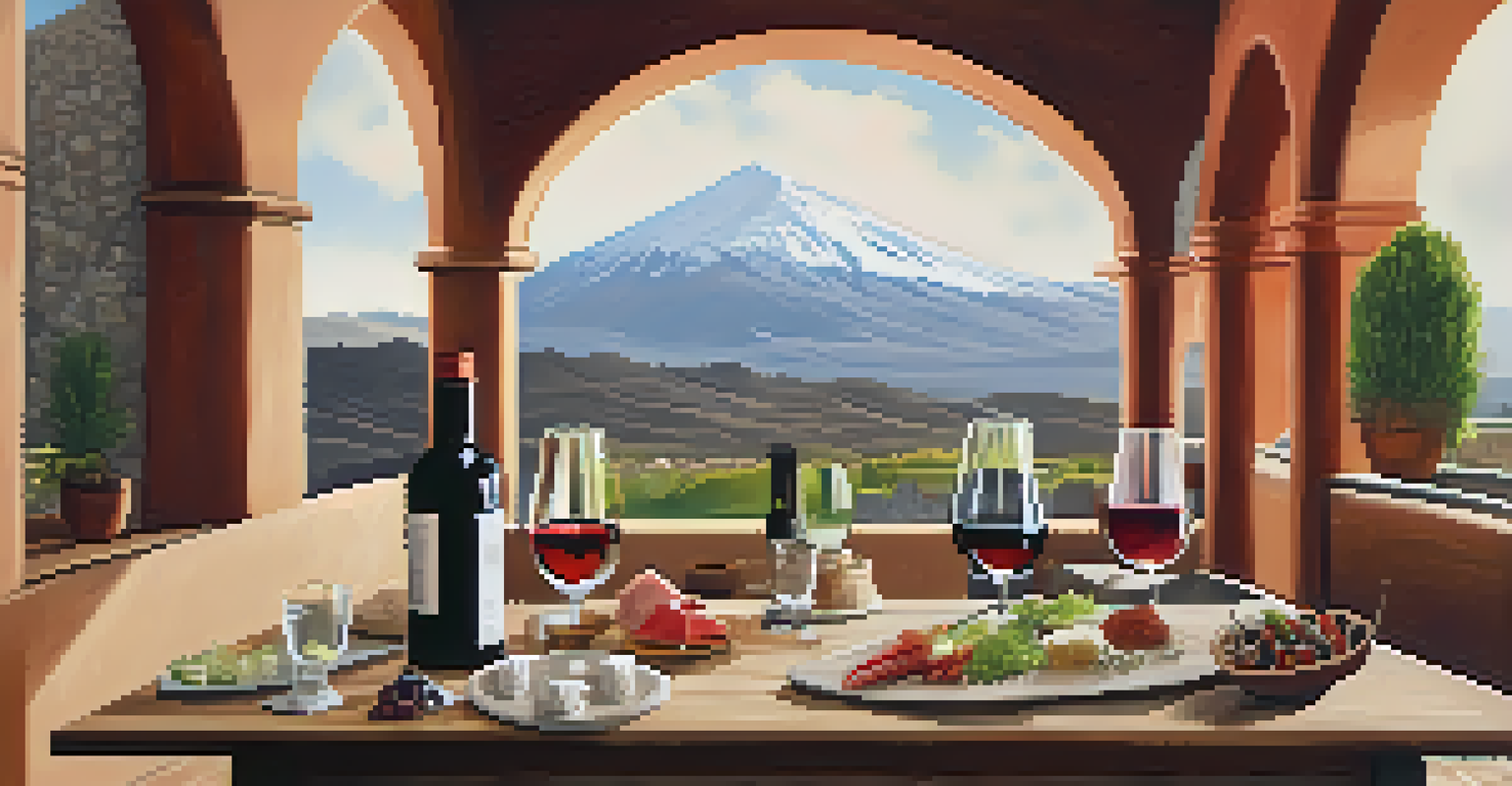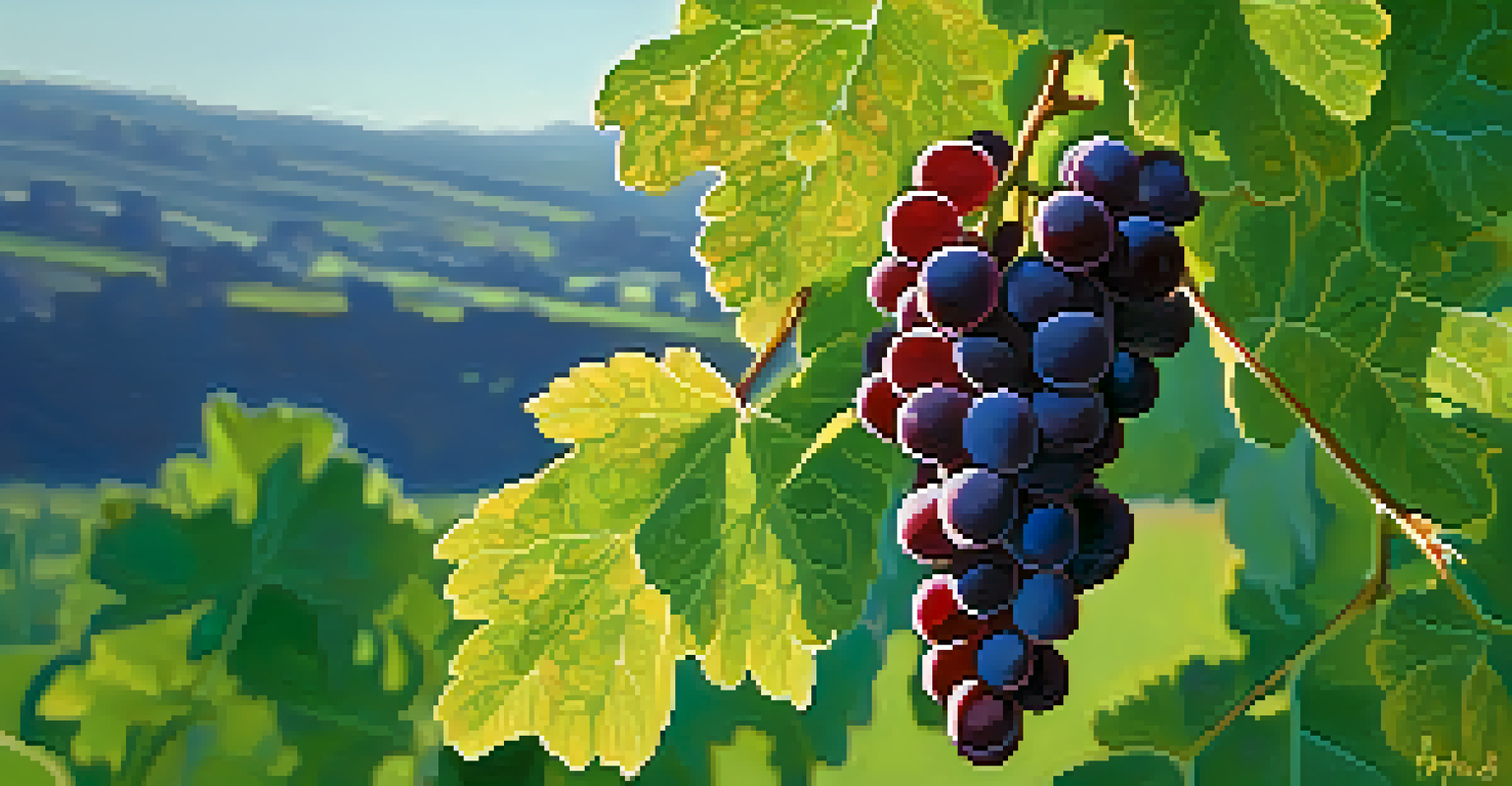Exploring Peruvian Wine: A Journey into Local Wine Regions

The Rise of Peruvian Wine: A Brief Overview
Peruvian wine has been gaining recognition on the global stage, showcasing a unique blend of tradition and innovation. With a rich history dating back to the Spanish colonization, the country has cultivated a distinctive winemaking culture. Today, vineyards are flourishing, particularly in regions like Ica and Arequipa, drawing attention from wine enthusiasts worldwide.
Wine is sunlight, held together by water.
The combination of diverse climates and altitudes allows for a variety of grape types to thrive. From the sun-soaked valleys to the cooler highlands, each region contributes its unique character to the wines produced. This geographical variety is key to understanding the depth and complexity of Peruvian wine.
As more people discover these hidden gems, the demand for Peruvian wine is on the rise. Wine festivals and tastings are becoming increasingly popular, making it an exciting time to explore this burgeoning industry.
Ica: The Heart of Peruvian Wine Production
Ica is often regarded as the epicenter of Peruvian wine, known for its warm climate and fertile soil. The region is home to many established vineyards, producing a wide range of wines, primarily from the Quebranta grape. These wines are characterized by their rich, fruity flavors and smooth finish, making them a favorite among local and international drinkers.

In Ica, visitors can explore iconic wineries such as Tacama and Vista Alegre, where guided tours offer insights into the winemaking process. Tasting sessions allow guests to sample various wines, immerse themselves in the local culture, and appreciate the craftsmanship involved. It's a delightful experience that blends education with enjoyment.
Peruvian Wine Gains Global Recognition
Peruvian wine is capturing attention worldwide due to its unique blend of indigenous grapes and diverse terroirs.
Additionally, Ica's proximity to the Nazca Lines adds an adventurous twist for wine lovers. After a day of tasting exquisite wines, a quick trip to see these ancient geoglyphs makes for an unforgettable day of exploration.
Arequipa: The City of Volcanoes and Wine
Arequipa, often called the 'White City' due to its volcanic stone architecture, also boasts a thriving wine scene. This region's unique geography, with its high altitudes and volcanic soil, produces wines with remarkable depth and character. The cooler climate allows for a longer growing season, which enhances the grapes' flavors.
The best wines are the ones we drink with friends.
Vineyards like Canta Mañana and La Caravedo are making waves with their premium wines, including aromatic whites and robust reds. Visitors can enjoy breathtaking views of the surrounding mountains while sipping on a glass of Arequipa's finest. It's a picturesque setting that enhances the wine-tasting experience.
Furthermore, Arequipa is a cultural hub, offering visitors a chance to indulge in local cuisine that pairs beautifully with the region's wines. This fusion of flavors from both the plate and the glass creates a feast for the senses, making Arequipa a must-visit for wine enthusiasts.
The Influence of Indigenous Grapes in Peruvian Wine
One of the most fascinating aspects of Peruvian wine is the use of indigenous grape varieties, which have been cultivated for centuries. Grapes like Quebranta and Torontel are integral to the country's winemaking identity, offering a unique taste that reflects the local terroir. These indigenous varieties are often overlooked but are gaining recognition for their quality and character.
Winemakers are increasingly embracing these traditional grapes, crafting wines that tell a story of Peru's rich cultural heritage. The revival of these indigenous varieties not only preserves historical practices but also introduces wine lovers to flavors they may not have encountered before.
Sustainable Practices Reshape Winemaking
Many vineyards in Peru are embracing eco-friendly practices, enhancing wine quality while promoting environmental stewardship.
By exploring these unique grapes, you not only enjoy a distinctive drinking experience but also contribute to the preservation of Peru's winemaking traditions. It's a beautiful way to connect with the land and its history through every sip.
Sustainable Practices in Peruvian Winemaking
Sustainability has become a crucial focus in the winemaking industry worldwide, and Peru is no exception. Many vineyards are adopting eco-friendly practices to reduce their environmental impact and promote biodiversity. From organic farming methods to water conservation techniques, these initiatives are reshaping the future of Peruvian wine.
Wineries like Tacama are leading the charge by implementing sustainable practices that enhance the quality of their wines while protecting the environment. Visitors can learn about these efforts firsthand during vineyard tours, gaining insight into the balance between winemaking and environmental stewardship.
By supporting sustainable wineries, consumers are also contributing to the preservation of Peru's stunning landscapes and ecosystems. It's a win-win situation, where enjoying a glass of wine aligns with a commitment to responsible environmental practices.
Pairing Peruvian Wine with Local Cuisine
Peruvian cuisine is renowned for its rich flavors and diverse ingredients, making it a perfect match for local wines. The country's culinary landscape includes dishes such as ceviche, lomo saltado, and causa, each offering a unique pairing opportunity. Understanding these combinations can elevate your dining experience to new heights.
For example, the crisp acidity of a Quebranta wine beautifully complements the freshness of ceviche, enhancing the dish's vibrant flavors. Similarly, a robust red from Arequipa pairs wonderfully with the hearty lomo saltado, creating a harmonious blend of taste and texture on your palate.
Pairing Wine with Local Cuisine
The rich flavors of Peruvian cuisine create perfect pairing opportunities with local wines, enhancing the overall dining experience.
Exploring these pairings adds an extra layer of enjoyment to your wine journey. Whether dining at a local restaurant or preparing a meal at home, experimenting with wine and food combinations can lead to delightful discoveries.
The Future of Peruvian Wine: Trends to Watch
As the Peruvian wine industry continues to evolve, several exciting trends are emerging. The focus on quality over quantity is gaining traction, with winemakers prioritizing the production of premium wines that reflect the unique characteristics of their regions. This shift is attracting both local and international attention, elevating Peru's status in the global wine market.
Additionally, the rise of boutique wineries is reshaping the landscape, offering consumers a more personalized experience. These smaller producers often experiment with innovative techniques and unique blends, providing a fresh perspective on Peruvian wine. Wine lovers can look forward to discovering hidden treasures that showcase the creativity of these artisans.

With an increasing number of wine festivals and events showcasing Peruvian wines, the future looks bright for this burgeoning industry. As more people become aware of the diversity and quality of Peruvian wine, it's an exciting time to explore and indulge in the country's vinous offerings.